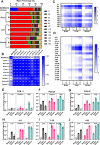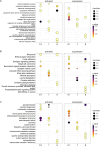Interactions of Polychlorinated Biphenyls and Their Metabolites with the Brain and Liver Transcriptome of Female Mice
- PMID: 39392776
- PMCID: PMC11587508
- DOI: 10.1021/acschemneuro.4c00367
Interactions of Polychlorinated Biphenyls and Their Metabolites with the Brain and Liver Transcriptome of Female Mice
Abstract
Exposure to polychlorinated biphenyls (PCBs) is linked to neurotoxic effects. This study aims to close knowledge gaps regarding the specific modes of action of PCBs in female C57BL/6J mice (>6 weeks) orally exposed for 7 weeks to a human-relevant PCB mixture (MARBLES mix) at 0, 0.1, 1, and 6 mg/kg body weight/day. PCB and hydroxylated PCB (OH-PCBs) levels were quantified in the brain, liver, and serum; RNA sequencing was performed in the striatum, prefrontal cortex, and liver, and metabolomic analyses were performed in the striatum. Profiles of PCBs but not their hydroxylated metabolites were similar in all tissues. In the prefrontal cortex, PCB exposure activated the oxidative phosphorylation respiration pathways, while suppressing the axon guidance pathway. PCB exposure significantly changed the expression of genes associated with neurodevelopmental and neurodegenerative diseases in the striatum, impacting pathways like growth hormone synthesis and dendrite development. PCBs did not affect the striatal metabolome. In contrast to the liver, which showed activation of metabolic processes following PCB exposure and the induction of cytochrome P450 enzymes, the expression of xenobiotic processing genes was not altered by PCB exposure in either brain region. Network analysis revealed complex interactions between individual PCBs (e.g., PCB28 [2,4,4'-trichlorobiphenyl]) and their hydroxylated metabolites and specific differentially expressed genes (DEGs), underscoring the need to characterize the association between specific PCBs and DEGs. These findings enhance the understanding of PCB neurotoxic mechanisms and their potential implications for human health.
Keywords: RNA sequencing; metabolomics; multiomics; network analysis; neurotoxicity; polychlorinated biphenyls.
Conflict of interest statement
The authors declare no competing financial interest.
Figures








Similar articles
-
Identification of polychlorinated biphenyls (PCBs) and PCB metabolites associated with changes in the gut microbiome of female mice exposed to an environmental PCB mixture.J Hazard Mater. 2025 Jun 5;489:137688. doi: 10.1016/j.jhazmat.2025.137688. Epub 2025 Feb 20. J Hazard Mater. 2025. PMID: 40020572
-
Perinatal exposure to polychlorinated biphenyls (PCBs) and child neurodevelopment: A comprehensive systematic review of outcomes and methodological approaches.Environ Res. 2024 Jul 1;252(Pt 2):118912. doi: 10.1016/j.envres.2024.118912. Epub 2024 Apr 13. Environ Res. 2024. PMID: 38615789
-
Prenatal and postnatal exposure to PCBs and neurodevelopment of preschoolers living in the PCB-contaminated region.Environ Res. 2025 Oct 1;282:122044. doi: 10.1016/j.envres.2025.122044. Epub 2025 May 31. Environ Res. 2025. PMID: 40456374
-
Polychlorinated biphenyls in various fish species farmed and caught in the Adriatic Sea over ten years: A health risk assessment.Sci Total Environ. 2025 Jul 30;996:180167. doi: 10.1016/j.scitotenv.2025.180167. Online ahead of print. Sci Total Environ. 2025. PMID: 40743756
-
Associations Between Maternal Polychlorinated Biphenyls (PCBs) Exposure from Seafood Consumption during Pregnancy and Lactation and Child Growth: A Systematic Review and Meta-Analysis.Adv Nutr. 2025 Jan;16(1):100350. doi: 10.1016/j.advnut.2024.100350. Epub 2024 Nov 30. Adv Nutr. 2025. PMID: 39617149 Free PMC article.
Cited by
-
Subacute exposure of male adolescent rats to 2,2',5,5'-tetrachlorobiphenyl-4-ol via a polymeric implant causes gene expression changes in the brain and metabolomic disruption in serum.Toxicology. 2025 Jun;514:154120. doi: 10.1016/j.tox.2025.154120. Epub 2025 Mar 15. Toxicology. 2025. PMID: 40097135
-
Identification of polychlorinated biphenyls (PCBs) and PCB metabolites associated with changes in the gut microbiome of female mice exposed to an environmental PCB mixture.J Hazard Mater. 2025 Jun 5;489:137688. doi: 10.1016/j.jhazmat.2025.137688. Epub 2025 Feb 20. J Hazard Mater. 2025. PMID: 40020572
-
Ramping up the Heat: Induction of Systemic and Pulmonary Immune Responses and Metabolic Adaptations in Mice.bioRxiv [Preprint]. 2025 Aug 2:2025.08.01.667768. doi: 10.1101/2025.08.01.667768. bioRxiv. 2025. PMID: 40766621 Free PMC article. Preprint.
References
-
- ATSDR . Toxicological profile for polychlorinated biphenyls. 2000. - PubMed
-
- EPA Polychlorinated Biphenyls (PCBs) . Inadvertent PCBs. https://www.epa.gov/pcbs/inadvertent-pcbs.
-
- Carlson L. M.; Christensen K.; Sagiv S. K.; Rajan P.; Klocke C. R.; Lein P. J.; Coffman E.; Shaffer R. M.; Yost E. E.; Arzuaga X.; Factor-Litvak P.; Sergeev A.; Toborek M.; Bloom M. S.; Trgovcich J.; Jusko T. A.; Robertson L.; Meeker J.; Keating A. F.; Blain R.; Silva R.; Snow S.; Lin C.; Shipkowski K.; Ingle B.; Lehmann G. M. A systematic evidence map for the evaluation of noncancer health effects and exposures to polychlorinated biphenyl mixtures. Environ. Res. 2023, 220, 115148.10.1016/j.envres.2022.115148. - DOI - PMC - PubMed
Publication types
MeSH terms
Substances
Grants and funding
LinkOut - more resources
Full Text Sources
Molecular Biology Databases

